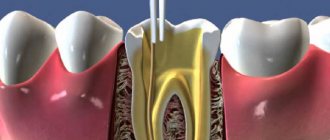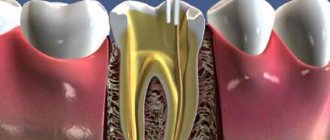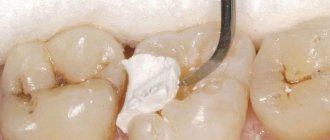Retrograde filling is a method of filling root canals with access through the root apex. It is indicated if it is impossible to carry out this procedure using the standard algorithm. Most often, it is used if it is impossible to remove previously installed filling material from the canal, although there are a number of other cases when this method is indicated. With the right approach, it prevents the penetration of pathogenic microorganisms through the root canals into periodontal tissue and alveolar bone and ensures effective closure of the apex area (root apex).
The CELT Dentistry Department invites you to undergo retrograde canal filling in Moscow. We have all the necessary licenses and certificates and work on the basis of an official contract with a guarantee. Our dentists have decades of experience in scientific and practical work, in which they are supported by a powerful diagnostic and treatment base, as well as effective and safe materials of the latest generation. You can find out the price of retrograde filling by going to the “Services and Prices” tab. We regularly update our price list, but to avoid misunderstandings, we recommend that you check the numbers with our information line operators or at a doctor’s appointment.
Dentist consultation - 1,000 rubles.
Retrograde canal filling (RTA) - 9,000 rubles.
Removing stitches - 350 rub.
At CELT you can get advice from a dental specialist.
- The cost of a consultation with a dental surgeon is 1,000
Make an appointment
Indications and contraindications for retrograde filling
Indications
- Impossibility of re-treatment of canals due to incorrectly previously filled canals using cement, pastes or their analogues, which does not allow unsealing;
- Anatomical features of the structure of the patient’s root canals, which are too long or have a strong curvature, which do not allow full endodontic treatment or make it impossible;
- Obliteration of root canals of various natures, including inflammation, malignant neoplasms, age-related changes and medical errors;
- The presence of fragments of endodontic files, anchor pins or stump inlays in the canal, which did not allow it to be hermetically sealed;
- The presence of a restoration on the tooth in the form of a fixed prosthesis, made of porcelain or metal ceramics, along with one or more of the above contraindications.
Contraindications
There are specific contraindications, which include mobility of teeth of the third or fourth degree due to periodontitis. At this stage of the disease, bone resorption exceeds 50% of the length of the tooth root, and the depth of the periodontal pockets is more than five millimeters.
In addition, there are a number of general contraindications that do not allow surgical dental interventions to be performed in the oral cavity. These include:
- Pregnancy in women;
- Periods of menstruation;
- Blood diseases that are characterized by disorders of blood clotting;
- Diabetes mellitus in the stage of decompensation;
- Infectious diseases in acute form;
- Chronic pathological conditions during periods of exacerbation;
- The patient has neoplasms of a malignant nature;
- Mental disorders.
Will the filling hurt later?
Aching pain after treatment is normal
After returning from dentistry and the anesthesia wears off, many patients feel pain under the filling. Here you should not immediately panic and run back to the doctor. Pain most often acts as a natural response of the body to external intervention. It may hurt quite badly for a couple of days, but the nature of the pain is more aching than sharp. It may also be uncomfortable to brush your teeth or drink hot or cold drinks - then you can take a painkiller tablet or rinse your mouth with a soda solution. Over time, the pain subsides. According to practicing doctors, the pain lasts for about a week, but can last for a month (if, for example, a three-canal tooth was treated).
It is important to know! Pain after root canal filling may also indicate the development of complications due to incorrect therapy. Here you need to listen to your feelings - if the pain is acute, continuous, increases (and does not weaken every day) or is accompanied by a high temperature, then contact your dentist immediately.
The essence of retrograde root canal filling and the materials used
The essence of retrograde root filling is apicoectomy or resection of the root apex. This is a surgical operation that is aimed at removing the apical part of the tooth (including the pathological focus, if any). Having gained access to the canal, the dental surgeon processes and seals it.
Amalgam for retrograde tooth root filling
Despite a number of significant advantages, this material is used less and less often, since it can cause darkening of the gums, and the filling method is too labor-intensive. Today it is being replaced by modern materials that significantly simplify this procedure. At the same time, it is worth noting a number of advantages of amalgam:
- Ability to maintain a given shape well;
- Minimal shrinkage.
Zinc oxide eugenol cements for retrograde tooth root filling
COE are materials based on eugenol and zinc oxide. They are well compatible with dental tissues, as well as:
- Absolutely inert to them;
- They have antiseptic properties;
- Do not cause changes in hard dental tissues.
Their hardening time ranges from ten to twelve hours.
Glass ionomer cements for retrograde filling of tooth canals
GIC is the latest generation of materials with excellent strength and aesthetic properties. They are not susceptible to carious processes, allow you to select the desired shade, and provide radiographic contrast. Their other advantages:
- Functionality in wet environments;
- Excellent adhesion to different materials;
- Release of fluoride ions during the first year;
- Minimal shrinkage.
Review of popular formulations
The list of filling materials is very large. They differ in their composition, strength and application technique. Let's look at the most popular ones.
COE
Refers to plastic non-hardening materials. Available in the form of an antiseptic paste, the composition includes zinc oxide and eugenyl liquid.
Has a number of disadvantages:
- do not harden;
- tend to gradually dissolve and be washed out from the upper part of the tooth root;
- are not used to restore the roots of permanent teeth.
Most often, this material is used in the treatment of baby teeth in children. COEs also have their advantages: they are easily removed from the root canal (if necessary), easily installed and are characterized by sufficient viability.
Restoration paste
Compared to the use of amagalma, this mass allows for better sealing of the tooth root. It is often used to treat periapical areas.
Super-EBA
The composition of this filling material contains zinc and aluminum oxide, and a small percentage of natural resins is also present.
This composition provides reliable protection against pathogenic organisms that have not shown their activity at the time of the procedure.
Glass ionomer cements
They are characterized by a high level of sealing and edge adaptation; reflective types of material are most often used. Used for filling the apical area.
Among other advantages it is worth highlighting:
- high adhesion to other materials used during the procedure;
- high biological compatibility with dental tissues;
- protects against violation of the marginal seal of installed fillings;
- long service life.
The choice of filling material is made by the dentist based on the problem of a particular patient.
The secret of the popularity of Spectrum fillings from Germany among specialists and patients.
In this publication you will find a detailed description of cement fillings.
Here https://zubovv.ru/lechenie/zubyi/plombyi/kakie-problemyi-reshayut-svetovyie-na-perednih.html we will talk about the intricacies of installing a light filling on a front tooth.
Reviews of doctors providing the service - Retrograde root canal filling
I am very grateful to Evgeniy Borisovich Antiukhin for removing my three eights.
Especially considering that the lower tooth was not the simplest (it was located in an embrace with a nerve). The removal took place in 2 stages, one tooth under local anesthesia, two under general anesthesia. I had no idea that wisdom teeth could be... Read full review Sofia
28.12.2020
Words cannot express my gratitude to Elena Nikolaevna Kiseleva. This is the best doctor in the world. I got an appointment after many years of being ignored by the dentist’s office and with a bitter experience of treatment in another paid clinic, the mistakes of which had to be corrected in the first visits. Thank you for this... Read full review
Roman Stanislavovich Sh
25.07.2020
Price
The retrograde filling procedure is not an expensive operation. The average price is in the range of 250-500 rubles.
This cost includes an examination by a dentist and the application of filling material. Separately, it is necessary to pay for anesthesia and additional procedures (preliminary treatment of nearby teeth, etc.).
The price is also affected by the quality of the chosen filling material. It is best to give preference to popular manufacturers and not save on it.
Preparation for retrograde tooth root filling
Before prescribing retrograde filling to a patient, CELT dentists conduct a full diagnostic study. It is indicated for microsurgical intervention and includes:
- Thorough dental examination;
- Sight radiography/panoramic photo;
- Test for individual intolerance to filling materials.
If there are no contraindications to filling, the dentist performs sanitation of the oral cavity, after which the patient is ready for intervention.
Clinical application of collagen and hydroxyapatite granules in filling bone defects
| Before treatment. There are extensive bone defects. | At the stage of surgical intervention. The defects are filled with granules of osteoplastic material. |
| Treatment result after 3 months. Partial osseointegration occurs as the graft material is absorbed. |
Principles of retrograde filling of the reserved root canal
It is carried out in several stages, which are as follows:
- Infiltration anesthesia - local anesthesia with the introduction of an anesthetic with a syringe into the soft tissue of the gums;
- Providing access to the apex of the root of a dental unit - an incision along the gum and peeling off its mucous membrane exposing the bone jaw tissue and excision of the apex of the root to the level of detection of the canals;
- Antiseptic treatment - the cavity remaining after excision is cleaned, removing fragments of pathological tissue from it (if any), filling it with tampons with an antiseptic;
- Preparation for retrograde filling - the apex is thoroughly dried and etched, after which the cavity is washed and also dried;
- Retrograde filling - the canal cavities are filled with filling materials, covered with tampons for five minutes to harden, after which antiseptic treatment is carried out and excess composition is removed;
- Suturing - the detached flap of gum is returned to its place and secured with sutures. During the first 48 hours after surgery, drainage will be required to drain the ichor.
General overview
The retrograde filling method is an alternative to the standard root canal therapy method. The procedure is carried out to prevent the penetration of pathogenic microorganisms into the periapical region through the dental canals.
This technique allows for reliable closure of the apical region. The principle of manipulation is to perform an apiectomy (surgical resection of the tooth root in the apical zone). After preparing the canal, treatment is carried out, and then it is closed with filling material.
Recovery period after retrograde canal filling
The sutures are removed no earlier than after five days. During the recovery period, the patient must follow the doctor’s recommendations, which are as follows:
- During the first half hour, apply an ice compress to reduce swelling;
- Avoid consuming food or liquid for the first two hours;
- Avoid any physical activity for 24 hours;
- Carry out hygiene procedures regularly, but use a toothbrush with soft bristles;
- Systematically rinse the mouth with decoctions of chamomile and sage;
- Take antibiotics and stimulants according to the regimen prescribed by your doctor.
You can make an appointment with CELT dental surgeons online on our website or by contacting our information line operators.
Make an appointment through the application or by calling +7 +7 We work every day:
- Monday—Friday: 8.00—20.00
- Saturday: 8.00–18.00
- Sunday is a day off
The nearest metro and MCC stations to the clinic:
- Highway of Enthusiasts or Perovo
- Partisan
- Enthusiast Highway
Driving directions









